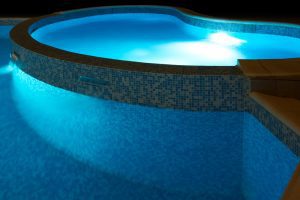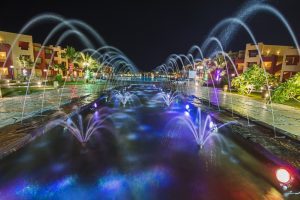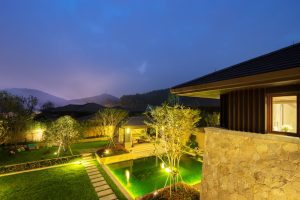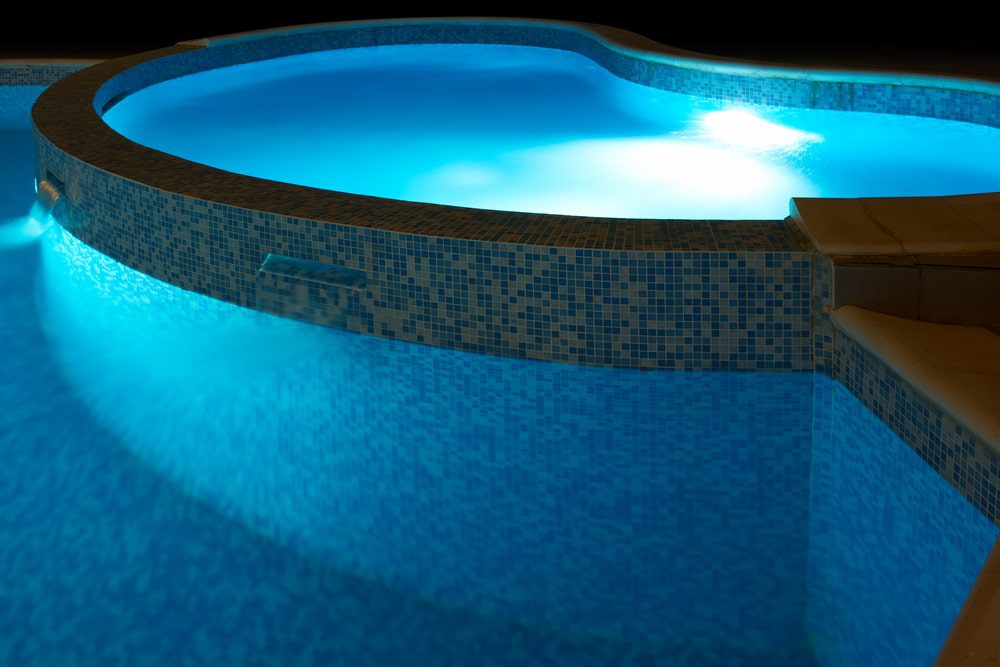Planning and keeping a water feature takes a lot of work. It takes a vision to create, lots of preparation to build, and time to maintain. But in the end, it’s all worth it.
The soothing sound of a babbling brook, the turning of water, and the serene setting it creates amplify the enjoyment we find in our landscapes. The big question is what happens to that water feature after sundown?
Most everyone finds their days filled with work and tasks that need to be accomplished before heading home. It usually isn’t until later in the day when people have a chance to unwind and enjoy their water features.
If the pond has become a ritualistic part of your routine, a serene characteristic of your landscape, then why not extend that enjoyment into the evening?
You’ve already created a beautiful water feature that you get to enjoy during the day. Why not take the opportunity to create a dramatic sight for your evening enjoyment as well? Read on for some important tips for pond and water feature lighting to maximize your outdoor spaces!
Keep the Focus on the Water – Not the Wires
Pond or water feature lighting is how you can keep your water feature from having to go to bed when the sun does. But you want to make sure those lighting wires are safely hidden from view. That’s why it’s best to install the wire and fixtures while assembling the fountain.
If you’re adding lighting components after the water feature is already there, keep in mind that some parts might have to be disassembled and then reassembled to camouflage wires and fixtures. Alternatively, you may add components like hollow faux rocks or bushes to hide the wires.
Pool And Outdoor Safety At Night
Some of the most common nighttime accidents are caused by not having proper outdoor lighting. When it is dark without light, residents and their guests have a higher likelihood of tripping over chairs, tables, and even pets. If someone falls into a pool at night, there is a high likelihood they will become disoriented, which can make it difficult for them to get out of the pool. If the pool is too shallow, they may suffer injury as well. This is why installing proper outdoor lighting is important for pool safety.
Pro Tip: Make sure to always see the edge of the water whether for a pool or a hot tub.
Facts To Consider For Water Feature Lighting
When doing water feature lighting, whether it be a pond, water garden, waterfall, fountain, or any combination, take into consideration what will work best for the immediate area surrounding your water.
Water vegetation, pond life, and statutory forms are all a part of the overall water feature. In order to really capture your water feature in the best light (no pun intended), your low voltage lighting system needs to capture important aspects of the whole composition.
Types of lighting categories that can be used include downlights, submersible lights, underwater up lights, wash lights, and path lights, among others.
Downlighting
Downlighting highlights the objects underneath. Therefore, downlighting is used often for ground-level features, such as water and even landscape beds. Downlighting features can also easily blend in with the yard to give more natural effects. Downlighting can be hidden behind rocks, trees, and even a diving board.
Uplighting
Uplighting is used more often to highlight structures by shining upwards. The upward lighting focuses on higher surfaces, such as a tree trunk or wall. Therefore, uplighting tends to not be used for water features. Though, it proves to highlight waterfalls or fountains well.
Combination Lighting
If you are really aiming toward that natural lighting effect, both uplighting and downlighting will prove most effective, since natural light does not have one specific angle. Downlight focuses on areas lower that may not get noticed in the dark, while uplight can help show off key architectural details higher up.
Cross Lighting
Cross lighting prevents unwanted shadow, by lighting parallel and opposite sides of the water structure, such as a fountain, bird bath, or waterfall. Though, cross lighting can be tricky to install correctly. Therefore, connecting with NightVision lighting experts is important to ensure the lighting design features are installed and placed correctly.
Resort Style Lighting

Underwater pool lights can create a resort-like atmosphere in your backyard
Combined with a private pool and private hot tub in your own home, proper lighting can give a relaxing environment as if on vacation at a resort. Proper directional lighting can highlight and emphasize the beauty of your water feature. Some types of lighting features to give a resort-style feel includes: well lighting and underwater lighting. One feature to consider is lighting zones. Lighting zones can help accentuate the resort-style landscape.
Lighting Zones
Lighting zones are efficient in many ways. Lighting can be set to stay on all night or set on a timer with a brightness or dimming setting via a controller. Depending on the event or experience, having designated lighting zones and settings can prepare the mood. For example: if you host many guests for a party or event, having brighter and possibly colorful water feature lighting would fit the mood, compared to a more romantic evening where the lighting may prefer to be dimmed. If you want to view the stores as well at night, dimming your water feature lighting can help see the stars clearer whether in the hot tub, pool, or just out of the water.
Lighting Colors

Vary lighting colors to create fanciful effect
There is a myriad of light colors that can be installed in your water features. With certain little installations, the light colors can rotate to a variety of different colors (such as blue, red, pink, violet, and so on). One popular lighting color is having a blue light shining into the water, with complementary softer lighting surrounding the water features. This is one way to give off a more natural light effect as if there is light shining from the moon.
Color Temperature
Color temperature is measured through Kelvin (K). As a vague explanation, red light and similar colors are warm light and blue and blue-like colors are considered cold or cool light. A warm color can range from approximately 1,000 to 6,000 degrees K, while cool colors can range from approximately 6,500 to 12,000 degrees K.
For example, underwater lighting fixtures tend to be at approximately 10,000 to 12,000 degrees Kelvin to show a lighter blue color. Some may prefer warmer dive lights at approximately 6,500 to 8,000 degrees Kelvin.
Another example is moonlighting at approximately 4,000 degrees Kelvin. If a lighting designer is trying to give a fireplace feel, they would add warmer lighting at approximately 2,700 degrees Kelvin.
Moonlight and Well Lights
Artificial light can give off a full moon-type lighting that can provide a naturally elegant feel. This can be done by hanging the light fixtures high above three focal points.
Well lights, being inside and at the same level as the ground, are an excellent option for a well-lit yard without becoming a hazard.
Spotlights
If these options are exhausted, avoid the temptation to try and light that tree from behind. While lighting from behind might conceptually seem like a great idea, remember that lighting from behind will ensure that the lighting effect is often obscured, and very likely to blind the onlooker with glare.
Take a Dive: Submersible Lights
Adding submersible or underwater lighting can add essence to the water features. Installing underwater lighting can be quite dangerous due to electricity and water, so this is not a DIY job. Instead, connect with NightVision lighting professionals to install submersible lighting for the safety of you and your loved ones.
Lighting Brightness
Finding the perfect lighting between too bright and too dim can prove difficult. One tip is to not create a light bomb by having too bright a light. A light bomb occurs when one goes from a really dark area to a very brightly lit area. The unexpected bright and blinding light can cause difficulty seeing. Therefore, finding an even medium between blindingly bright and too dark to see is important. Now with new technology, the proper lighting brightness measurement can be designed best for you.
The recommended lighting for a pool and pond is approximately 200 to 400 lumens depending on the size and depth. Hence, connecting with lighting professionals such as NightVision for a proper consultant and design.
Purposeful Fixture Placement
The big secret to lighting is to design purposefully with light, not fixtures. Before doing anything you will want to recursively ask yourself a question: “Why light?” What do you want to capture with light?
It’s only after figuring this out that you will decide on the appropriate fixture and placement. For example, if you have a beautiful ornamental Japanese Maple tree with branches spread out over the waterfall or a fountain surrounded by a flower bed, how will you light it?
Choose Your Angles Carefully
Always consider the viewing angles, where you will be observing. These are all matters you will encounter when trying to create a balanced lighting effect.
Ideally, you’d like to light it from below, but the water feature is in the exact spot the fixture should ideally go. Is it possible to downlight that Japanese Maple, or use an underwater fixture?
The most successful way to identify the best lighting angles and design for you is by hiring a local professional, such as NightVision Outdoor Lighting.
Select Materials That Will Last
LED lighting materials are much more resilient, environmentally friendly, and long-lasting lighting compared to the typical outdoor lighting such as the halogen light bulb, sodium lights, and metal halide. LED lighting’s energy efficiency is not only eco-friendly but financially feasible as well. Outdoor lighting can bring out the art of your yard.
Low voltage lighting is also a long-lasting, safe, and versatile LED option. The low-profile lighting brings out the best and most detailed landscape of your yard and can be easily concealed behind flowerbeds, among other places. If you accidentally knock down the light or cords, you will be put in no danger due to the low voltage levels.
The lighting must be water resistant and corrosion resistant. The wires and lighting should be mostly indoors or by waterproof switches if outside. Therefore, to ensure proper installation, working with your local outdoor lighting experts is important to protect you, your loved ones, and your pets.
Remember that Less is More

Backyard lighting for a modern villa
Sometimes having less light is more to give off that natural light essence. Sometimes, dimmer and warmer light is better. Warmer light not only provides a cozy environment but can also provide an opportunity for stargazing without all the bright cold light pollution blocking the view. Imagine staring at the stars with your loved ones!
Have Fun with the Design
Having fun with your approach will help you to get in the right mindset! Get a flashlight and try different angles at night. Try different positions, different locations, and even different types of light (colored light versus not or warm light versus cold light). Have fun seeing how things look when they are lit from different viewpoints. Imagine your flashlight is the fixture: see how you like the play of the angles and shadows when lit from different places.
Choose an Outdoor Lighting Design Expert
Choosing an outdoor lighting expert is as important a step as any in your outdoor lighting journey Here is some guidance to help you with this big decision!
Bona Fide Outdoor Lighting Experts
Make sure to pick a lighting company that will actually design the lighting placement as well as installs the lighting. If the lighting is designed poorly the end result can be satisfying or poorly lit.
Can the Design be Adjusted or Expanded in the Future?
Adjusting the design can be difficult in the future if designed poorly. Therefore, connecting with lighting design experts can ensure lighting placements that will allow changes and expansion of lighting design and fixtures.
Energy Efficiency
Make sure that LED lights are being installed instead of halogen lights. This is because halogen lighting is less energy efficient compared to LED light’s 12-volt system.
Maintaining the Lighting System
LightVision is easy to contact. Though we provide excellent quality light bulbs, light bulbs do have a lifespan that will eventually need replacing. Hence, we can replace the light bulbs for you quickly and efficiently in order to not disrupt your outdoor night activities.
To learn more about the best practices for pond or water feature lighting contact NightVision Outdoor Lighting today or give us a call at 678-828-2999.



